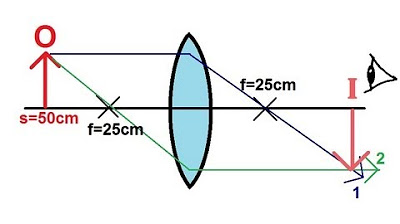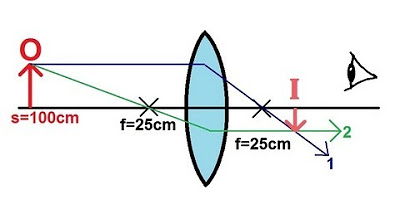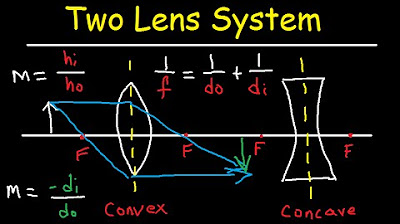Physics - Optics: Lenses (4 of 4) Converging Lens
TLDRThis educational script explains the behavior of a converging lens with a focal length of 25 cm when an object is placed within the focal point. It details the formation of a virtual image using ray diagrams and equations, resulting in an upright, magnified image 2.5 times larger than the object. The script illustrates the principle behind magnifying glasses and reading glasses, showing how they make objects appear larger and easier to see, which is essential for vision correction.
Takeaways
- 🔎 The script discusses the behavior of a converging lens with a positive focal length of 25 cm.
- 📌 The object is placed inside the focal point, closer to the lens than the focal point itself.
- 💡 The use of a ray diagram is explained to determine the path of light rays through the lens.
- 👀 The first ray is drawn parallel to the principal axis and refracted through the lens to pass through the focal point on the other side.
- 📐 The second ray is drawn from the object through the lens's focal point, illustrating its path after refraction.
- 🤔 The rays do not converge to form a real image behind the lens, but the observer perceives a virtual image due to the brain's interpretation of the rays' paths.
- 📚 The lens formula \( S' = \frac{SF}{S - F} \) is used to calculate the image distance, resulting in a negative value indicating a virtual image.
- 🔢 The calculated image distance is -37.5 cm, which means the virtual image is formed on the same side as the object but appears to be behind the lens.
- 🔄 The magnification formula \( m = -\frac{S'}{S} \) is used to determine the image size, showing the image is 2.5 times larger than the object and upright.
- 🔍 This setup is analogous to how magnifying glasses work, creating a virtual, upright, and magnified image of an object placed within the focal length of a converging lens.
- 👓 The script also mentions the application of such lenses in vision correction, specifically for presbyopia, where the user has difficulty seeing objects that are close.
Q & A
What is the focal length of the converging lens described in the script?
-The focal length of the converging lens is 25 cm.
Why is the focal length of a converging lens positive?
-The focal length of a converging lens is positive because it converges light rays towards a focal point, which is characteristic of converging lenses.
Where is the object placed relative to the lens in the example?
-The object is placed inside the focal point, meaning it is closer to the lens than the focal point's position.
What happens to the light rays when they pass through the converging lens according to the script?
-The light rays are refracted by the lens and either continue through the focal point or diverge after passing through the lens.
What type of image is formed when the object is placed inside the focal point of a converging lens?
-A virtual image is formed when the object is placed inside the focal point of a converging lens.
How does the brain interpret the diverging rays to form an image?
-The brain interprets the diverging rays as if they came from a single point behind the lens, forming a virtual image.
What is the formula used to calculate the image distance (S') in the script?
-The formula used to calculate the image distance is S' = F / (s - F), where F is the focal length and s is the object distance.
What was the calculated image distance for the given example, and what does the sign of the result indicate?
-The calculated image distance was -37.5 cm, and the negative sign indicates that the image is a virtual image located on the same side as the object.
What is the magnification of the image in the example, and what does the positive sign of the result indicate?
-The magnification of the image is 2.5 times the size of the object, and the positive sign indicates that the image is upright.
How does the script relate the example of the converging lens to magnifying glasses and reading glasses?
-The script explains that the example demonstrates how magnifying glasses and reading glasses work by creating a larger, upright virtual image of an object placed closer than the focal point.
What is the practical application of a converging lens when the object is placed inside the focal point?
-The practical application includes using it as a magnifying glass to make objects appear larger and easier to see, as well as for vision correction for those who have difficulty seeing objects up close.
Outlines
🔍 Understanding Converging Lenses and Virtual Images
This paragraph explains the behavior of a converging lens with a positive focal length of 25 cm when an object is placed inside the focal point. The description uses a ray diagram to illustrate how rays diverge after passing through the lens, forming a virtual image. The observer perceives a virtual image larger than the actual object due to the brain's interpretation of the rays' paths. The equations for image distance (S' = 25(S - F) / (S - F)) and magnification (m = -S' / S) are used to calculate the virtual image's position and size, revealing a 2.5 times larger, upright image. This principle is applied in magnifying glasses and reading glasses to aid vision for close-up objects.
Mindmap
Keywords
💡Converging Lens
💡Focal Length
💡Object Distance
💡Ray Diagram
💡Virtual Image
💡Magnification
💡Upright Image
💡Lens Formula
💡Negative Image Distance
💡Magnifying Glass
💡Vision Correction
Highlights
Working with a converging lens with a positive focal length of 25 cm.
Object placed inside the focal point, closer to the lens than the focal point.
Ray diagram technique explained for converging lenses.
First ray drawn parallel to the normal, refracts through the lens and continues through the focal point.
Second ray drawn from the object through the focal point, refracts and continues straight.
Two rays do not converge to form a real image, indicating a virtual image formation.
Virtual image formed due to brain's interpretation of non-converging rays.
Equation used to calculate image distance: S' = (SF)/(S - F).
Object distance (S) is 15 cm, resulting in a negative image distance of -37.5 cm.
Negative image distance indicates a virtual image located in front of the lens.
Magnification formula m = -S'/S used to determine image size.
Image magnified 2.5 times larger than the object, upright and virtual.
Positive magnification indicates the image is upright.
Demonstration of how a magnifying glass works using a converging lens.
Application of converging lenses in reading glasses and vision correction.
Lenses used to magnify and correct vision for those with difficulty seeing up close.
Summary of the lens experiment, including image distance, virtual image, and magnification.
Transcripts
Browse More Related Video

Physics 54 Optics: Mirrors (3 of 6) Concave Mirror

Physics - Optics: Lenses (2 of 4) Converging Lens

Physics - Optics: Lenses (3 of 4) Converging Lens

Physics - Optics: Lenses (2 of 2) Diverging Lens

Physics - Optics: Lenses (1 of 4) Converging Lens

Multiple Two Lens System with Diverging and Converging Lens
5.0 / 5 (0 votes)
Thanks for rating: